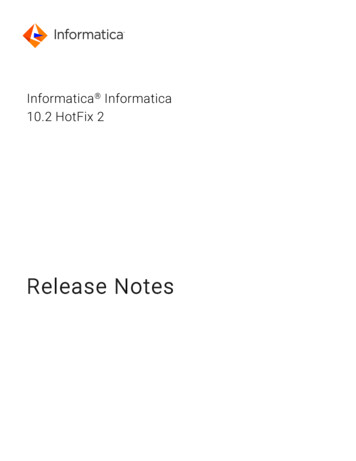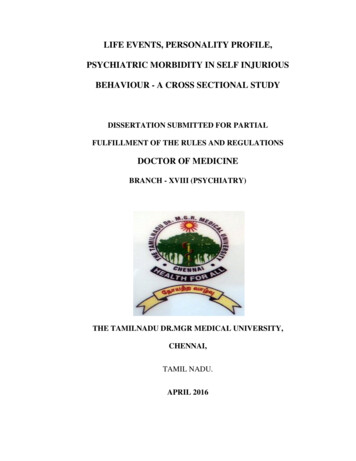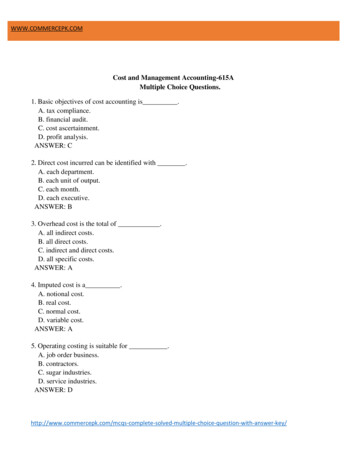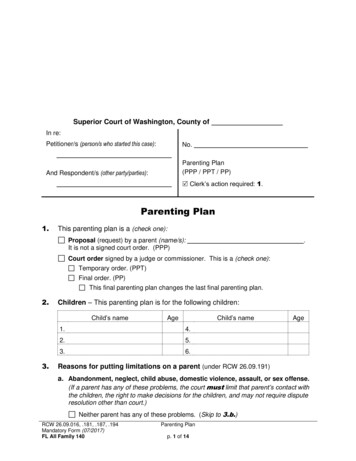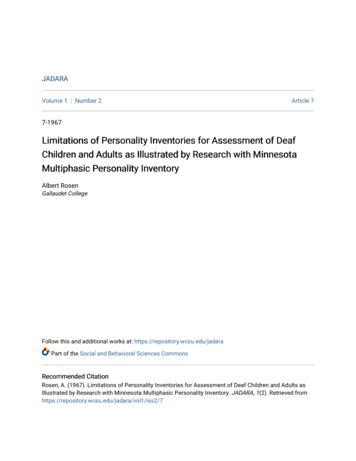
Transcription
JADARAVolume 1Number 2Article 77-1967Limitations of Personality Inventories for Assessment of DeafChildren and Adults as Illustrated by Research with MinnesotaMultiphasic Personality InventoryAlbert RosenGallaudet CollegeFollow this and additional works at: https://repository.wcsu.edu/jadaraPart of the Social and Behavioral Sciences CommonsRecommended CitationRosen, A. (1967). Limitations of Personality Inventories for Assessment of Deaf Children and Adults asIllustrated by Research with Minnesota Multiphasic Personality Inventory. JADARA, 1(2). Retrieved fromhttps://repository.wcsu.edu/jadara/vol1/iss2/7
Rosen: Limitations of Personality Inventories for Assessment of Deaf ChiLIMITATIONS OF PERSONALITY INVENTORIES FORASSESSMENT OF DEAF CHILDREN AND ADULTS ASILLUSTRATED BY RESEARCH WITH THE MINNESOTAMULTIPHASIC PERSONALITY INVENTORYALBERT ROSENPersonality assessment of the deaf by methods requiring spoken language is difficult or impossible in most cases. Structured personalityinventories, which do not require mutual oral interaction, have therefore appeared attractive. The Minnesota Multiphasic Personality Inventory (MMPI), since its introduction over twenty-five years ago,has become widely used and the subject of over 2000 research reports.Myklebust, in the only previous report on the application of the MMPIto the deaf, has asserted that it is useful for this group. It seemedespecially appropriate, therefore, to study this instrument with the deaf.This article will summarize recent analyses of the responses of deaf college preparatory students to MMPI items, and present conclusions regarding the limited validity of this and other inventories used inthe past. First, what is meant by a structured personality inventory?(1) It is typically a series of statements or questions relating to selfconcept, aspirations, avocations, health, symptoms, interpersonal rela* Available from the writer on request, the following paper presents the technical details of the analyses: Rosen, A. MMPI Responses of Deaf CollegePreparatory Students: Limitations of Personality Inventories in a LanguageDeficient Minority Culture. Washington, D.C.: Gallaudet College, 1967. Unpublished manuscript.ALBERT ROSEN is Research Professor at Gallaudet College, Washington, D.C.Published by WestCollections: digitalcommons@wcsu,1
JADARA, Vol. 1, No. 2 [], Art. 748JOURNAL OF REHABILITATION OF THE DEAFtions, vocational interests, sex, religion, motives, fears, energy level,mood, ego strength, perception of reality, and a variety of traits, suchas self-sufl5ciency, responsibility, dominance,etc.(2) These items are to be answered True or False, or Yes or No,with an opportunity not to respond to some items, but with an exhortation to answer as many as possible.(3) These responses are scored objectively on predetermined scalessuch as Depression, Social Introversion, Conformity, Affiliation, etc.,depending on the notions of the inventory constructors about the dimensions of personality worth,and feasible measuring.(4) The pattern or profile of scales may then be interpreted clinically (subjectively) or statistically (objectively, mechanically) in describing or in making judgments about an individual, such as his suitability for a specific educational or vocational program, the bases forhis problems with peers or parents or other authority figures, his needfor psychological treatment, and methods for carrying it out.These tests are referred to as 'structured" because the response islimited to a few specified alternatives rather than being more or lessopen or unspecified as in a so-called projective test.The MMPI items have been estimated to require about a sixth-grade reading level for their comprehension. From previous researchwith hearing persons much is known about the meaning of the MMPIscales for description and decision-making with a variety of peopleand problems. The inventory consists of 566 items answered True orFalse or Cannot Say on a machine-scorable form, and is scored on atleast 14 basic scales. These are ten clinical scales, labelled Hypochondriasis. Depression, Hysteria, Psychopathic Deviate, MasculinityFemininity, Paranoia, Psychasthenia, Schizophrenia, Hypomania, andSocial Introversion. Each scale (with a few exceptions) is comprised ofthose items which were answered in a significantly different way from"normals" by a diagnostic group (e.g., psychotically depressed patients)in a mental hospital. Research and experience in other settings, however, have indicated that the usefulness of the scales is not limited topsychiatric diagnosis. There are also four "validity scales" designed toindicate whether the respondent has answered in a manner suggestingthat the results are suspect. For example, one score is a count of unanswered items. Another scale score (F scale) is based on items rarelyanswered in the scored direction; a high score generally suggests difficulty in comprehension or random answering. Two other scales (Land K) provide information on defensiveness in /iss2/72
Rosen: Limitations of Personality Inventories for Assessment of Deaf ChiLIMITATIONS OF PERSONALITY INVENTORIES49METHOD AND RESULTSIn the fall of 1963, virtually the entire entering preparatory class of Gallaudet College was administered the MMPI in groups of 25 to70, and almost all completed the test. The most striking feature of theaverage profiles of these 96 males and 83 females was the suggestionof extreme psychopathology. The deaf students had scores and profileswhich were similar to those of hospitalized schizophrenic patients.Compared to large samples of MMPI scores from hearing college students, the deaf students appeared markedly aberrant. Inspection of theprofile sheet for each of the 179 deaf students indicated that the greatmajority of the profiles were of psychotic type. Likewise, the use of objective statistical procedures classified a large majority of the profilesas psychotic.These results obviously did not coincide with clinical impressionsconcerning the psychological status of the deaf students. A series ofanalyses was conducted in order to determine the bases of their MMPIresponses. Their standardized reading test scores were analyzed, special tests were constructed and administered to measure comprehension of idioms and of specific MMPI items, selected item responseswere studied, and the Schizophrenia scale (the clinical scale mostdeviant in 1963) was administered to the entering preparatory class inthe fall of 1964 with the request that the students circle the numbers ofthose items they didn't understand. The results will be summarizedaccording to type of analysis.Reading level. Nationally standardized reading tests classified thesestudents at a mean level slightly higher than the seventh grade, with nosignificant sex difference. Unfortunately, these results are somewhat indoubt. The forms of tests used, designed for students in the tenth,eleventh, and twelfth grades, were far too difficult for the deaf students. What the mean reading level might have been with differenttests, if any really appropriate ones could be found, is hard to postdiet. If the seventh-grade level is approximately correct, then a highpercentage of the preparatory students were perilously close to theirceiling of comprehension on a personality inventory designed for atleast sixth-grade readers.Comprehension of idioms. Standardized reading tests are notmeasuring adequately the kinds of difficulty deaf students experience in Since few deaf students are able to obtain a complete high school curriculumin special educational facilities for the deaf, such as residential schools and special schools and classes, a preparatory year is provided at Gallaudet College forapproximately 85 percent of new students.Published by WestCollections: digitalcommons@wcsu,3
JADARA, Vol. 1, No. 2 [], Art. 750JOURNAL OF REHABILITATION OF THE DEAFreading in general and especially on the MMPI. A specially constructed test of elementary idioms indicated that these preps were, onthe average, far below normally hearing pupils in nearby public schoolswith mean reading level of grade 6.6. It was estimated that the deafstudents fell at approximately the fifth-grade level on comprehension ofidioms. The standardized reading tests contained few idioms whereasone-fifth of the MMPI items included idioms. Moreover, the inventoryitems are generally brief, so that contextual clues to meaning, so common in reading test paragraphs, are imavailable.MMPI item comprehension test, A specially devised test of imder-standing of individual items, with norms from a nearby college forhearing students, suggested a serious comprehension difficulty in a largepercentage of the deaf students, and a tendency for mdividuals notunderstanding the items to answer in a deviant direction.Circling of troublesome items. Those items designated as most difficult to comprehend by the 1964 group (by their chclmg of the itemnumbers) contained words, phrases, and idioms which were apparentlyat an elementary level.Analysis of individual MMPI items. The large percentage of deafstudents responding in the deviant direction to selected items reflectingextreme psychopathology, such as delusions and hallucinations, suggested the following conclusion: Even if these items are understood,the deaf must be interpreting them in a different way than do the hearing. The deaf in many ways fit the definition of a minority culturewhose values and test-taking attitudes are sufficiently different to produce unusual test responses.DISCUSSION AND CONCLUSIONSGalludet College is the world's only college for the deaf. Since fewdeaf persons can survive academically in a college for the hearing,practically all deaf college students attend Gallaudet. These studentsare the elite, intellectually, of the deaf world. If, through languagedeficiency and membership in a minority culture, the preps respond toa personality inventory in an extremely deviant way, it can be reasonably assumed that other deaf individuals of lesser intellectual andlinguistic caliber will do likewise. With respect to the cultural difference, there is considerable evidence that the MMPI, which has beentranslated into several foreign languages, cannot be interpreted on the'The preparatory class does not include approximately 15 percent of enteringstudents each year who are advanced to the freshman class because of relativelysuperior language s2/74
Rosen: Limitations of Personality Inventories for Assessment of Deaf ChiLIMITATIONS OF PERSONALITY INVENTORIES51basis of norms from the United States even in other English-speakingcoimtries.On the basis of these findings, it seems justifiable to conclude thatthe MMPI should be administered to the deaf only for research on itsuses and limitations, or for studies of item revision and constructionbased on suitable criterion data. There is a strong temptation whenone is attempting to assess the personality of a deaf person to use aninventory requiring no mutual oral interaction, especially if one is notconversant with the language of signs. Since frequently the evaluationof a deaf person is made because he is suspected of being deviant, it isan easy matter to accept as valid and to rationalize the almost invariable aberrant results. It is best to do without the test than to try tointerpret the profile on the basis of research and clinical experiencewith hearing persons. The only appropriate clinical use of the inventory is with older adolescents and adults whose deafness is of fairlyrecent onset.It seems highly likely that the responses of deaf children and adultsin previous research with structured personality inventories other thanthe MMPI have been markedly affected by these same comprehensionproblems and differences from the hearing in test-taking attitudes anditem interpretations. For example, approximately 90 percent of deafpersons are below the fifth-grade reading level. Thus, the resultsof these studies (using inventories developed by Bernreuter, Brown,Brunschwig, Rogers, and Thurstone), which have reported considerable psychopathology among the deaf, should be seriously questioned.Where does this leave us with respect to meaningful ways of assessingthe personality of deaf individuals? The validity of other assessmentprocedures dependent upon language (e.g., projective techniques suchas the Rorschach) has not been established. Only with much laboriousresearch can we determine whether any generally useful comprehensive inventory or other assessment procedure dependent upon languageresponses of deaf subjects can be constructed. The development andvalidation of nonverbal procedures may prove rewarding. At presentwe must rely on crude information from interviews, observations, andinformants concerning individuals in a culture which has been inadequately studied.SUMMARYPrevious research with the deaf based on their responses to structured personality inventories should be treated with great skepticism.Published by WestCollections: digitalcommons@wcsu,5
JADARA, Vol. 1, No. 2 [], Art. 752JOURNAL OF REHABILITATION OF THE DEAFResearch with the Minnesota Multiphasic Personality Inventory hasled to the conclusion that procedures dependent upon language responses have not been suitable for personality assessment of the deaf.Even in cases where language development may not be severely deficient, membership in the "deaf culture" apparently produces unusualtest-taking behavior. Several other inventories used in research withthe deaf in the past have probably presented misleading results for thesame reasons. If their responses are interpreted in terms of norms forthe hearing, the great majority of deaf persons are incorrectly diagnosed as suffering from extreme psychopathology. Further researchwith modifications of existing devices or development and validation ofnew ones is 2/76
MULTIPHASIC PERSONALITY INVENTORY. ALBERT ROSEN. Personality assessment of the deaf by methods requiring spoken lan. guage is difficult or impossible in most cases. Structured personality. inventories, which do not require mutual oral interaction, have there fore appeared attractive. The Minnesota Multiphasic Personality In ventory (MMPI .


